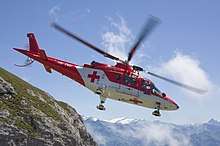Transverse flow effect
Transverse flow effect is an aerodynamic effect encountered when a helicopter moves (typically forward) through the air.
In a hover, the air above the rotor disk is being pulled down from above and is equally distributed around the rotor disk. The air is descending from above, which has the effect of reducing angle of attack.
As the helicopter starts moving into undisturbed air, a portion of the disk is in clean, unaccelerated air, while the remaining portion of the rotor disk is still working on descending air. The part of the disk working on clean air therefore sees a higher angle of attack than the portion of the disk which is working on descending air. This causes a difference in lift between the section in clean air and the section in descending air. The result is that the portion in clean air develops more lift, and the disk tilts as a result. Which way the disk tilts depends on a couple of factors:
Phase lag (rotorcraft) will cause the extra lift to be seen approximately 90 degrees later in rotor rotation in semi-rigid two bladed rotor systems. Phase lag is a separate phenomenon from gyroscopic precession. Phase lag is a property of all rotating systems acted upon by a periodic force. For systems hinged at the axis of rotation (in our case, a semi rigid flapping type rotor head) the phase lag is 90 degrees. For systems that are hinged at some distance from the axis of rotation (such as a fully articulated rotor head) the phase lag is less than 90 degrees. In forward flight the pilot will experience either a right or left roll (see flight dynamics), depending upon whether the rotor of the helicopter rotates counter-clockwise or clockwise.
Which way the helicopter rotor disk moves against the direction of the relative wind will determine which part of the disk has higher lift. For instance, hovering sideways, or hovering stationary in a crosswind, the clean portion of the disk would be to the side, rather than the front of the rotor disk. Depending on the main-rotor rotation direction this might be seen as a nose pitch up or nose pitch down, a roll, or something in between.
While a helicopter accelerates into a higher airspeed, more and more of the rotor disk will be in clean air and the lift differential will decrease. At some higher airspeed the effect will disappear. In a typical single rotor helicopter, the effect can be felt to start at around 5-10 knots, increases in magnitude to a maximum around 20 knots, and decreases above that until it is almost completely gone by 40-60 knots of airspeed.
